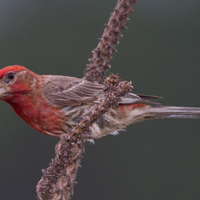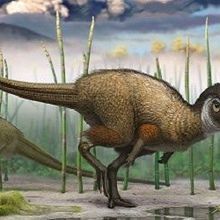Login
Subscribefeathers

Image of the Day: Feather Feeders
Emily Makowski | Dec 11, 2019 | 1 min read
These ancient insects ate dinosaur feathers during the Cretaceous period.

Image of the Day: Red-Feathered Finches
Emily Makowski | Sep 30, 2019 | 1 min read
Scientists uncover a potential reason why redder house finches have better health.

Pterosaurs Sported Feathers, Claim Scientists
Anthony King | Dec 17, 2018 | 4 min read
A controversy over pterosaurs’ plumage has taken off, with a new discovery pushing feather origins back 80 million years into the early Triassic.

Image of the Day: Shark Skin
Ashley Yeager | Nov 8, 2018 | 1 min read
Fish scales follow a model famed computer scientist Alan Turing developed to describe patterns observed in other animals’ feathers, spines, and scales.

Image of the Day: Birds of a Lung
Shawna Williams | Oct 22, 2018 | 1 min read
A fossil from the Cretaceous Period shows similarities to modern avian species.

Image of the Day: Birds of a Feather
Sukanya Charuchandra | Jul 10, 2018 | 1 min read
Despite containing similar chemical pigments, red and yellow parrot feathers display distinct hues.

Image of the Day: 99-Million-Year-Old Blood Sucker
The Scientist and The Scientist Staff | Dec 13, 2017 | 1 min read
Scientists have found the oldest known specimen of a blood-sucking insect together with the remains of its host.

Image of the Day: Stretchy Chicken Skin
The Scientist | Aug 25, 2017 | 1 min read
In a developing chicken embryo, skin cells pull on each other, forming multicellular mounds that eventually turn into properly-spaced feathers.

Dinosaur Feathers Found in Amber
Joshua A. Krisch | Dec 11, 2016 | 1 min read
The first-of-its-kind sample includes both vertebral segments and feathers.

Source of Scales, Feathers, Hair
Tanya Lewis | Jun 27, 2016 | 1 min read
Reptiles, birds, and mammals all produce tiny, bump-like structures during development.

Color Clues in Dino Fossils
Karen Zusi | Aug 31, 2015 | 1 min read
Researchers confirm that some microscopic imprints in fossilized dinosaur feathers are pockets of melanin.

“Feathered Poodle From Hell” Dino Found
Kerry Grens | Jul 20, 2015 | 1 min read
A newly discovered relative of Velociraptor had abundant plumage and birdlike wings.

Scales Over Feathers
Amanda B. Keener | Jun 3, 2015 | 1 min read
A comprehensive analysis of fossilized dinosaur skin samples suggests feathers were not the norm.

Avian-Inspired Color
Amanda B. Keener | May 26, 2015 | 2 min read
By taking cues from bird feathers, scientists engineer nanoparticle structures that produce striking colors.

Fossil Freshens Views on Dinosaur Feathers
Jyoti Madhusoodanan | Jul 28, 2014 | 2 min read
A feather-covered herbivorous dinosaur offers a surprising perspective on plumage.
Dinosaurs’ Shiny Black Feathers
Cristina Luiggi | Mar 9, 2012 | 1 min read
A 130 million-year-old winged dinosaur offers scientist the oldest evidence of iridescent feathers.
Ruffling Dinosaur Feathers
Cristina Luiggi | Sep 15, 2011 | 2 min read
Dinosaur and early bird feathers trapped in amber around 80 million years ago provide unprecedented insight into the evolution of plumage.

Early Bird Plumage
Cristina Luiggi | Sep 15, 2011 | 1 min read
After rummaging through thousands of amber inclusions housed at the University of Alberta and the Royal Tyrrell Museum of Paleontology in Canada, researchers discovered 11 amber encased-feather fossils that provide the most detailed picture yet of early feather evolution.
